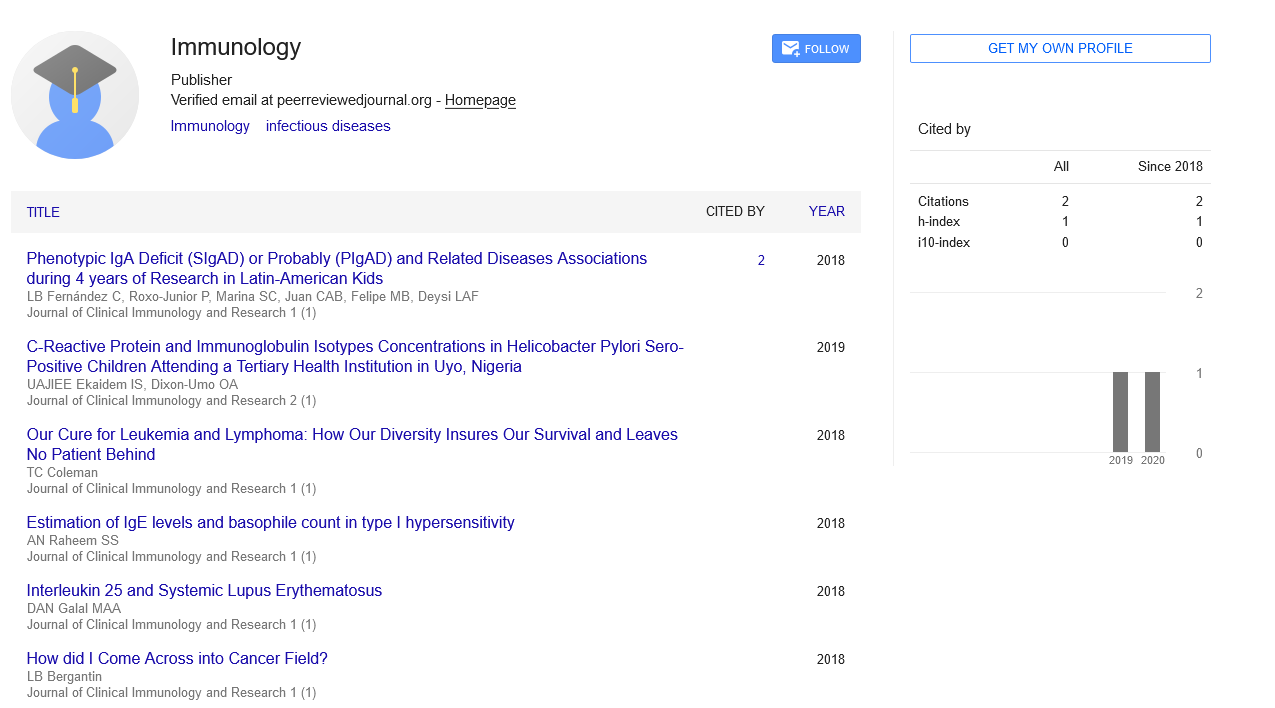Perspective, J Clin Immunol Res Vol: 8 Issue: 1
Immunosenescence: Understanding Age-Related Changes in Immune Function
Hadil Elldakli*
Department of Biology and Biochemistry, University of Houston, Houston, United States of America
*Corresponding Author:Hadil Elldakli
Department of Biology and Biochemistry, University of Houston, Houston, United States of America
E-mail:Elldakli.h2@Central.uh.edu
Received date: 27 December, 2023, Manuscript No. JCIR-23-123700;
Editor assigned date: 29 December, 2023, PreQC No. JCIR-23-123700 (PQ);
Reviewed date: 12 January, 2024, QC No. JCIR-23-123700;
Revised date: 19 February, 2025, Manuscript No. JCIR-23-123700 (R);
Published date: 26 February, 2025, DOI: 10.4172/JCIR.1000097
Citation: Elldakli H (2025) Immunosenescence: Understanding Age-Related Changes in Immune Function. J Clin Immunol Res 8:1.
Abstract
Immunosenescence, the aging-related decline in immune function, is a complex and multifaceted process that profoundly impacts the health and well-being of the elderly population. This manuscript provides a comprehensive review of immunosenescence, exploring the molecular and cellular changes that occur in the immune system with aging. From alterations in immune cell populations to shifts in cytokine profiles and the implications for vaccination and disease susceptibility, the review aims to enhance our understanding of immunosenescence and its implications for the aging population.
Keywords: Immunosenescence, Vaccination, Immune, Aging
Introduction
Definition of immunosenescence: Immunosenescence refers to the gradual deterioration of the immune system associated with aging. This phenomenon encompasses a range of changes, including alterations in immune cell composition, impaired immune responses, and increased susceptibility to infections and chronic diseases.
Importance of understanding immunosenescence: As the global population ages, understanding immunosenescence becomes increasingly critical for public health. The impact of age-related changes in immune function extends beyond infectious diseases, affecting responses to vaccinations, cancer surveillance, and autoimmune disorders.
Cellular changes in immunosenescence
T cell senescence: A hallmark of immunosenescence is the decline in T cell function. The manuscript delves into the molecular mechanisms underlying T cell senescence, including telomere shortening, altered signaling pathways, and the impact on adaptive immunity.
Changes in B cell populations: Age-related changes in B cells contribute to decreased antibody production and impaired humoral immunity. The review explores alterations in B cell subsets, antibody diversity, and the implications for vaccine responses.
Natural Killer (NK) cell dysfunction: NK cells, crucial for innate immunity, also undergo functional changes with aging. The manuscript discusses the impact of NK cell dysfunction on antiviral defenses and tumor surveillance.
Description
Inflammatory changes and immunomodulation
Chronic low-grade inflammation (Inflammaging): Immunosenescence is associated with a state of chronic low-grade inflammation termed inflammaging. The manuscript explores the role of inflammaging in age-related diseases and its contribution to immune dysfunction.
Immunomodulatory changes: Changes in regulatory T cells (Tregs) and other immunomodulatory mechanisms influence the balance between inflammatory and anti-inflammatory responses. The manuscript examines how these alterations contribute to immune dysregulation in aging.
Impact on vaccination
Reduced vaccine efficacy: Immunosenescence poses challenges for vaccination strategies, with elderly individuals exhibiting reduced responsiveness to vaccines. The manuscript discusses the implications for influenza, pneumococcal, and other vaccines commonly administered to the aging population.
Strategies to enhance vaccine responses: The review explores potential strategies to enhance vaccine responses in the elderly, including the development of adjuvanted vaccines, personalized vaccination approaches, and novel vaccine formulations.
Immunosenescence and infectious diseases
Increased susceptibility to infections: Immunosenescence contributes to an increased susceptibility to various infections, including respiratory viruses, bacterial pathogens, and reactivation of latent viruses. The manuscript examines the mechanisms underlying heightened vulnerability.
Viral reactivation and chronic infections: Age-related changes in immune function can lead to the reactivation of latent viruses such as Cytomegalovirus (CMV) and Herpes Simplex Virus (HSV), with implications for overall health and the exacerbation of agerelated diseases.
Immunosenescence and chronic diseases Cancer: Immunosenescence plays a role in cancer development and progression. The manuscript explores how age-related changes in immune surveillance contribute to increased cancer incidence and challenges in cancer immunotherapy for the elderly.
Autoimmune disorders: Paradoxically, immunosenescence is associated with an increased risk of certain autoimmune disorders. The manuscript discusses the delicate balance between immune activation and tolerance in aging, influencing autoimmune disease development.
Lifestyle factors and interventions
Influence of lifestyle on immunosenescence: The manuscript reviews the impact of lifestyle factors, including diet, exercise, and sleep, on immunosenescence. Understanding modifiable factors is crucial for promoting healthy aging and preserving immune function.
Immunomodulatory interventions: Emerging interventions, including senolytic drugs, caloric restriction, and modulation of the gut microbiota, show promise in mitigating aspects of immunosenescence. The manuscript discusses their potential as therapeutic strategies.
Conclusion
Immunosenescence represents a complex interplay of cellular, molecular, and inflammatory changes that significantly impact the immune function of aging individuals. As our understanding of immunosenescence deepens, opportunities arise for the development of targeted interventions to enhance immune responses in the elderly. Recognizing the multifaceted nature of immunosenescence is crucial for advancing strategies to promote healthy aging and improve the quality of life for the elderly population.
 Spanish
Spanish  Chinese
Chinese  Russian
Russian  German
German  French
French  Japanese
Japanese  Portuguese
Portuguese  Hindi
Hindi 